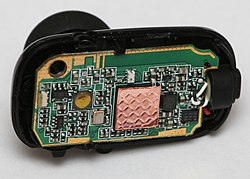 Bluetooth is a standard and communications protocol primarily designed for low power consumption, with a short range (power-class-dependent: 1 meter, 10 meters, 100 meters) based on low-cost transceiver microchips in each device.[5] Bluetooth makes it possible for these devices to communicate with each other when they are in range. Because the devices use a radio (broadcast) communications system, they do not have to be in line of sight of each other.[4]
Bluetooth is a standard and communications protocol primarily designed for low power consumption, with a short range (power-class-dependent: 1 meter, 10 meters, 100 meters) based on low-cost transceiver microchips in each device.[5] Bluetooth makes it possible for these devices to communicate with each other when they are in range. Because the devices use a radio (broadcast) communications system, they do not have to be in line of sight of each other.[4]Main article: Bluetooth profile
In order to use Bluetooth, a device must be compatible with certain Bluetooth profiles. These define the possible applications and uses of the technology.
[edit] List of applications
A typical Bluetooth mobile phone headset.
Nokia BH-208 headset internals.
More prevalent applications of Bluetooth include:
* Wireless control of and communication between a mobile phone and a hands-free headset. This was one of the earliest applications to become popular.
* Wireless networking between PCs in a confined space and where little bandwidth is required.
* Wireless communication with PC input and output devices, the most common being the mouse, keyboard and printer.
* Transfer of files, contact details, calendar appointments, and reminders between devices with OBEX.
* Replacement of traditional wired serial communications in test equipment, GPS receivers, medical equipment, bar code scanners, and traffic control devices.
* For controls where infrared was traditionally used.
* Sending small advertisements from Bluetooth-enabled advertising hoardings to other, discoverable, Bluetooth devices[citation needed].
* Two seventh-generation game consoles, Nintendo's Wii[6] and Sony's PlayStation 3, use Bluetooth for their respective wireless controllers.
* Dial-up internet access on personal computers or PDAs using a data-capable mobile phone as a modem.
[edit] Bluetooth IEEE 802.15.1 vs. Wi-Fi IEEE 802.11 in networking
Bluetooth and Wi-Fi have many applications in today's offices, homes, and on the move: setting up networks, printing, or transferring presentations and files from PDAs to computers. Both are versions of unlicensed wireless technology.
Wi-Fi is intended for resident equipment and its applications. The category of applications is outlined as WLAN, the wireless local area networks. Wi-Fi is intended as a replacement for cabling for general local area network access in work areas.
Bluetooth is intended for non resident equipment and its applications. The category of applications is outlined as the wireless personal area network (WPAN). Bluetooth is a replacement for cabling in a variety of personally carried applications in any ambience.
[edit] Bluetooth devices
A Bluetooth USB dongle with a 100m range.
Bluetooth exists in many products, such as telephones, the Wii, PlayStation 3, Lego Mindstorms NXT and recently in some high definition watches, modems and headsets. The technology is useful when transferring information between two or more devices that are near each other in low-bandwidth situations. Bluetooth is commonly used to transfer sound data with telephones (i.e. with a Bluetooth headset) or byte data with hand-held computers (transferring files).
Bluetooth protocols simplify the discovery and setup of services between devices. Bluetooth devices can advertise all of the services they provide. This makes using services easier because more of the security, network address and permission configuration can be automated than with many other network types.

Wi-Fi
Wi-Fi is more like a traditional Ethernet network, and requires configuration to set up shared resources, transmit files, and to set up audio links (for example, headsets and hands-free devices). Wi-Fi uses the same radio frequencies as Bluetooth, but with higher power, resulting in a stronger connection. Wi-Fi is sometimes called "wireless Ethernet." This description is accurate, as it also provides an indication of its relative strengths and weaknesses. Wi-Fi requires more setup but is better suited for operating full-scale networks; it enables a faster connection, better range from the base station, and better security than Bluetooth.

No comments:
Post a Comment